Evaluation and Optimization Paths of Design Elements of Underground Building Atria Based on IPA–Kano Model
Abstract
1. Introduction
2. Method
2.1. IPA–Kano Model
2.2. Optimization Method
2.3. Experimental Process
- (1)
- We conducted and collated questionnaires to calculate the mean importance and attribute performance values of atrium design elements of underground buildings in the three cases.
- (2)
- The importance and attribute performance bivariate was correlated using spss22.0 data statistical analysis software to extract the implied importance of atrium design elements of underground buildings [24].
- (3)
- The IPA–Kano analysis raster was used to present the comparative results of explicit and implicit importance, using importance data to represent explicit importance on the horizontal axis and bivariate correlation analysis data of importance and attribute performance to describe implicit importance on the vertical axis. The mean value of the 33 elements of explicit and implicit importance was used as the central coordinate, and each element corresponded to the quadrant diagram, respectively.
- (4)
- Based on the results of the quadrant attribution of the atrium design elements of underground buildings, the optimization path was analyzed by combining the performance ranking of each element attribute.
3. Indicator and Data
3.1. Design Elements of Underground Building Atria
3.2. Questionnaire Design
3.3. Research Cases and Data
4. Results
4.1. Importance and Attribute Performance Analysis
4.2. Extraction of Implicit Importance of Design Elements
4.3. Evaluation of Design Elements of Underground Building Atria
5. Discussion
6. Conclusions
Author Contributions
Funding
Data Availability Statement
Conflicts of Interest
References
- Huang, T.S.; Franck, K.A. Let’s meet at Citicorp: Can privately owned public spaces be inclusive? J. Urban Des. 2018, 4, 499–517. [Google Scholar] [CrossRef]
- Lee, D. Whose space is privately owned public space? Exclusion, underuse and the lack of knowledge and awareness. Urban Res. Pract. 2020, 15, 366–380. [Google Scholar] [CrossRef]
- Cui, J.Q.; Lin, D. Utilization of underground pedestrian systems for urban sustainability. Tunn. Undergr. Space Technol. 2015, 55, 194–204. [Google Scholar] [CrossRef]
- He, J.; Zacharias, J.; Geng, J.; Liu, Y.N.; Huang, Y.S.; Ma, W.H. Underground pedestrian network for urban commercial development in Tsim Sha Tsui of Hong Kong. In Proceedings of the 15th International Scientific Conference Underground Urbanisation as a Prerequisite for Sustainable Development, St. Petersburg, Russia, 12–15 September 2016; Volume 165, pp. 193–204. [Google Scholar]
- Sterling, R.; Admiraal, H.; Bobylev, N.; Parker, H.; Godard, J.P.; Vähäaho, I.; Rogers, C.D.F.; Shi, X.; Hanamura, T. Sustainability issues for underground space in urban areas. Urban Des. Plan. 2012, 165, 241–254. [Google Scholar] [CrossRef]
- Schmidt, S.; Nemeth, J.; Botsford, E. The evolution of privately owned public spaces in New York City. Urban Des. Int. 2011, 4, 270–284. [Google Scholar] [CrossRef]
- Broere, W. Urban underground space: Solving the problems of today’s cities. Tunn. Undergr. Space Technol. 2016, 55, 245–248. [Google Scholar] [CrossRef]
- Ma, C.-X.; Peng, F.-L.; Qiao, Y.-K.; Li, H. Influential factors of spatial performance in metro-led urban underground public space: A case study in Shanghai. Tunn. Undergr. Space Technol. 2022, 8, 229–251. [Google Scholar] [CrossRef]
- Zhang, J.; Qu, Q.Q.; Hu, B.; Yuan, L. Research on the spatial image design countermeasures of the soft guiding system of the underground complex. Chin. J. Undergr. Space Eng. 2016, 3, 587–592. (In Chinese) [Google Scholar]
- Mi, J.; Xu, L.Q.; Tang, Z. Path-finding experiment and space-oriented research in underground public space—Taking Shanghai People’s Square as an example. Archit. J. 2007, 12, 66–70. (In Chinese) [Google Scholar]
- Zhao, J.; Künzli, O. An introduction to connectivity concept and an example of physical connectivity evaluation for underground space. Tunn. Undergr. Space Technol. 2016, 55, 205–213. [Google Scholar] [CrossRef]
- Taek, L.M. A Study on the Revitalization of the Underground Shopping Mall as Experiential Intermediate Space-Focused on the Euljiro underground shopping mall. J. Korea Intitute Spat. Des. 2013, 8, 127–135. [Google Scholar]
- Wang, Q.; Zeng, J. The construction of disaster prevention planning system for high-density city center. Archit. J. 2012, S2, 144–148. (In Chinese) [Google Scholar]
- Du, Y.; Chen, J. Research on the Quality Attribution of Design Elements for the Entrance and Exit of Subway in Cold Region Based on IPA-Kano Method. Archit. J. 2018, S1, 144–148. (In Chinese) [Google Scholar]
- Yin, J.; Cao, X.J.; Huang, X.; Cao, X. Applying the IPA–Kano model to examine environmental correlates of residential satisfaction: A case study of Xi’an. Habitat Int. 2016, 53, 461–472. [Google Scholar] [CrossRef]
- Arbore, A.; Busacca, B. Rejuvenating importance-performance analysis. J. Serv. Manag. 2011, 22, 409–429. [Google Scholar] [CrossRef]
- Cai, C.Y.; Luo, P.C.; Tang, C.C.; Zhang, X.Y. Evaluation of Tourist Satisfaction in the World Heritage Sites of Folk Houses Based on the IPA Method—A Case Study of Yongding Earth Building in Fujian. Resour. Sci. 2011, 7, 1374–1381. (In Chinese) [Google Scholar]
- Kondo, Y. Customer satisfaction: How can I measure it? Total Qual. Manag. 2001, 12, 867–872. [Google Scholar] [CrossRef]
- Yang, J. Evaluation of demand index for tourist souvenirs in Shaanxi Han and Tang Dynasties based on Kano-AHP model. Packag. Eng. 2017, 4, 239–247. (In Chinese) [Google Scholar]
- Matzler, K.; Sauerwein, E. The factor structure of customer satisfaction: An empirical test of the importance grid and the penalty-reward-contrast analysis. Int. J. Serv. Ind. Manag. 2002, 13, 314–332. [Google Scholar] [CrossRef]
- Tontini, G.; Silveira, A. Identification of satisfaction attributes using competitive analysis of the improvement gap. Int. J. Oper. Prod. Manag. 2007, 27, 482–500. [Google Scholar] [CrossRef]
- Matzler, K.; Sauerwein, E.; Heischmidt, K. Importance-performance analysis revisited: The role of the factor structure of customer satisfaction. Serv. Ind. J. 2003, 23, 112–129. [Google Scholar] [CrossRef]
- Chen, K.S.; Chen, H.T. Applying Importance–Performance Analysis with Simple Regression Model and Priority Indices to Assess Hotels Service Performance. J. Test. Eval. 2014, 42, 455–466. [Google Scholar] [CrossRef]
- Lai, I.K.W.; Hitchcock, M. Importance–performance analysis in tourism: A framework for researchers. Tour. Manag. 2015, 48, 242–267. [Google Scholar] [CrossRef]
- Chen, Z.L.; Wu, T. Discussion on the design of the atrium of the underground building. Undergr. Space 2002, 4, 347–349+355–373. (In Chinese) [Google Scholar]
- Yan, B.; Jia, X.M.; Wang, J.Y. Study on the Evaluation of the Vitality Contribution of Underground Public Space in the Central City. Chin. J. Undergr. Space Eng. 2020, 2, 334–344. (In Chinese) [Google Scholar]
- Xiao, J.; Cao, K. Research on the Evaluation System of Humanized Design of Underground Space in Mountainous City—Taking the Six Commercial Districts of Chongqing as an Example. J. West. Hum. Settl. Environ. 2019, 34, 9–17. (In Chinese) [Google Scholar]
- Yuan, H.; Meng, Q.; Cui, X.; Pan, K. Research on the Urban Design of Underground Space in the Urban Central District—Building a “Double Layer” City on the Ground. J. West. Hum. Settl. 2016, 31, 88–94. (In Chinese) [Google Scholar]
- Chebat, J.C.; Gélinas-Chebat, C.; Therrien, K. Lost in a mall, the effects of gender, familiarity with the shopping mall, and the shopping values on shoppers’ wayfinding processes. J. Bus. Res. 2005, 58, 1590–1598. [Google Scholar] [CrossRef]
- Azzopardi, E.; Nash, R. A critical evaluation of importance–performance analysis. Tour. Manag. 2013, 35, 222–233. [Google Scholar] [CrossRef]

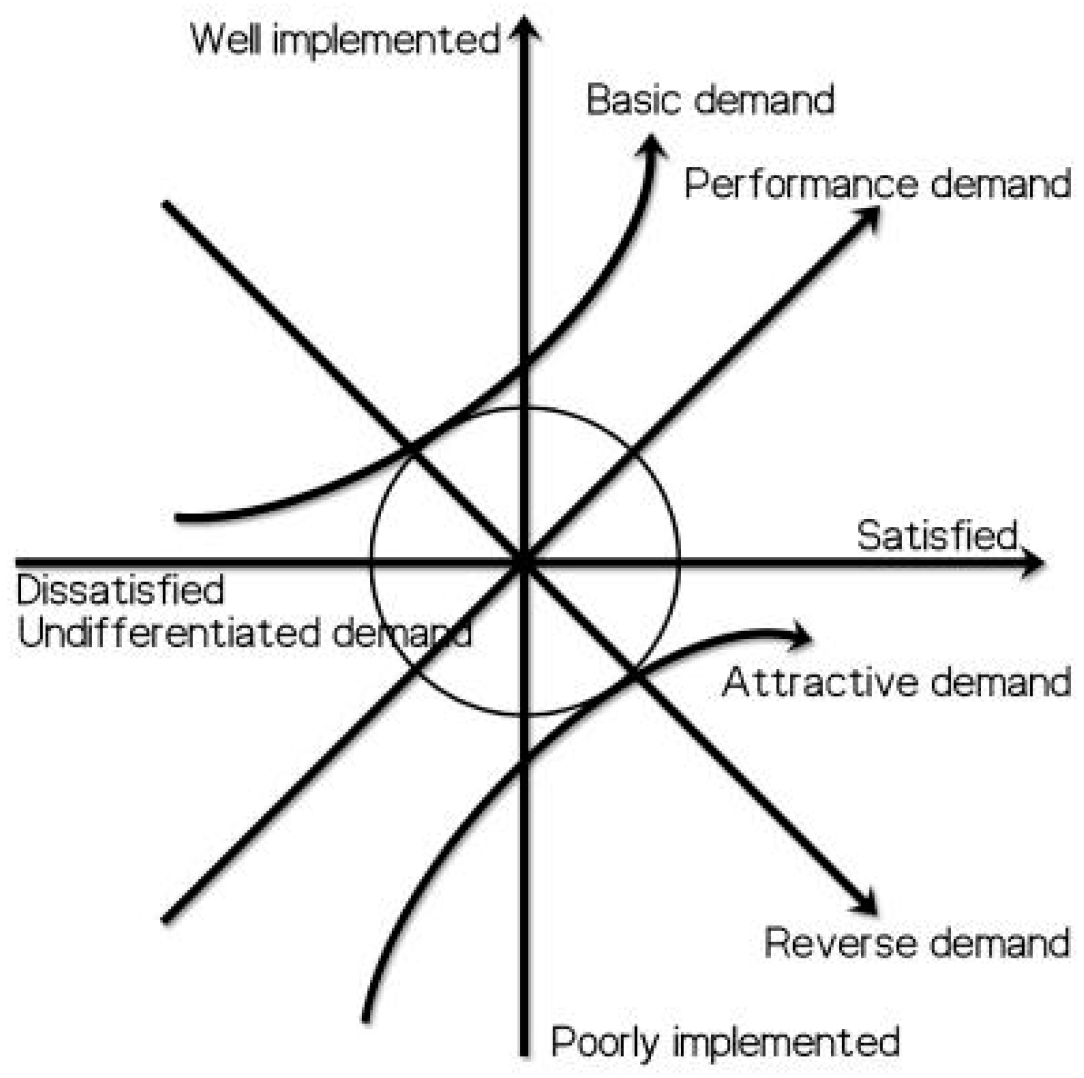
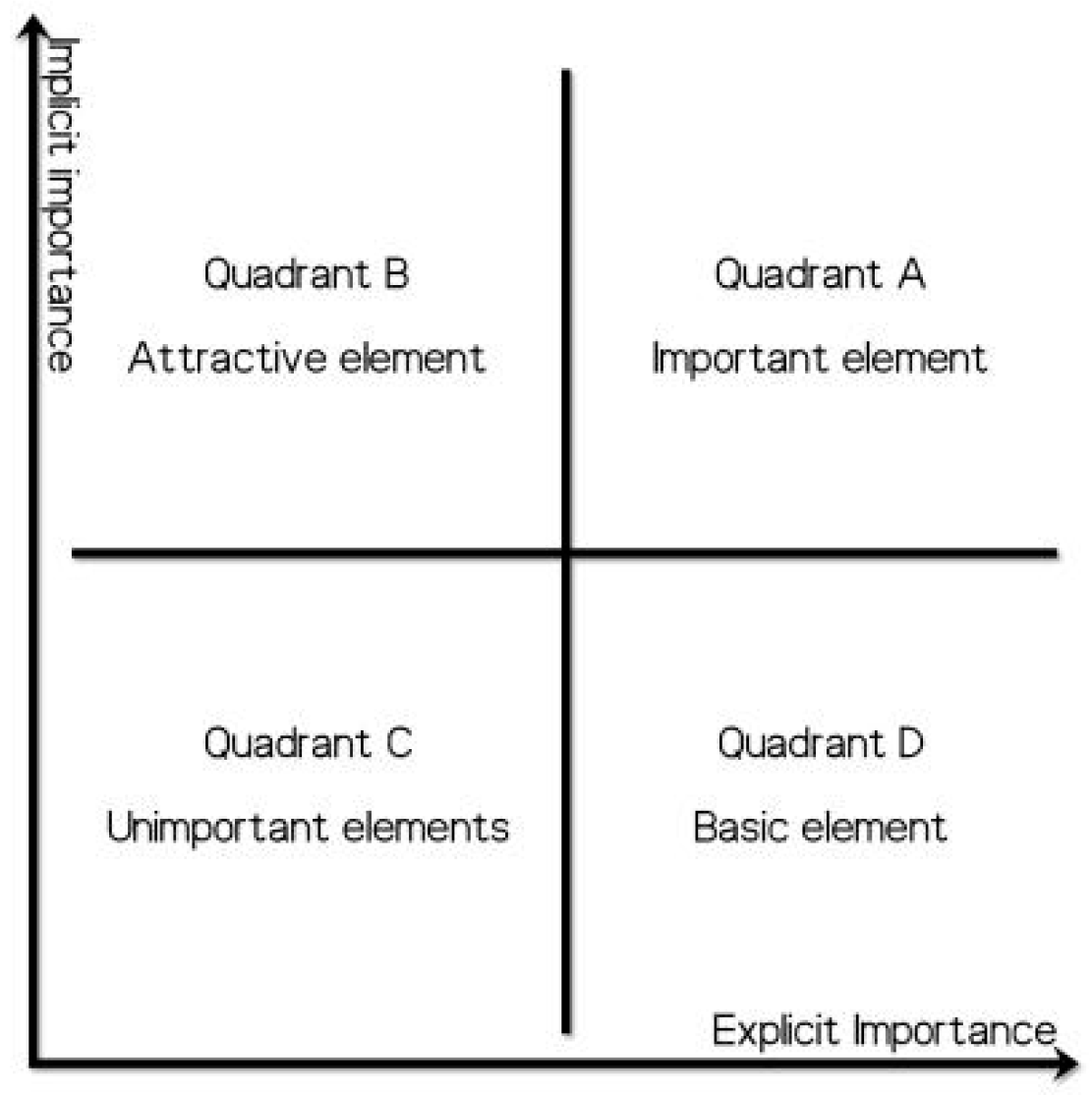

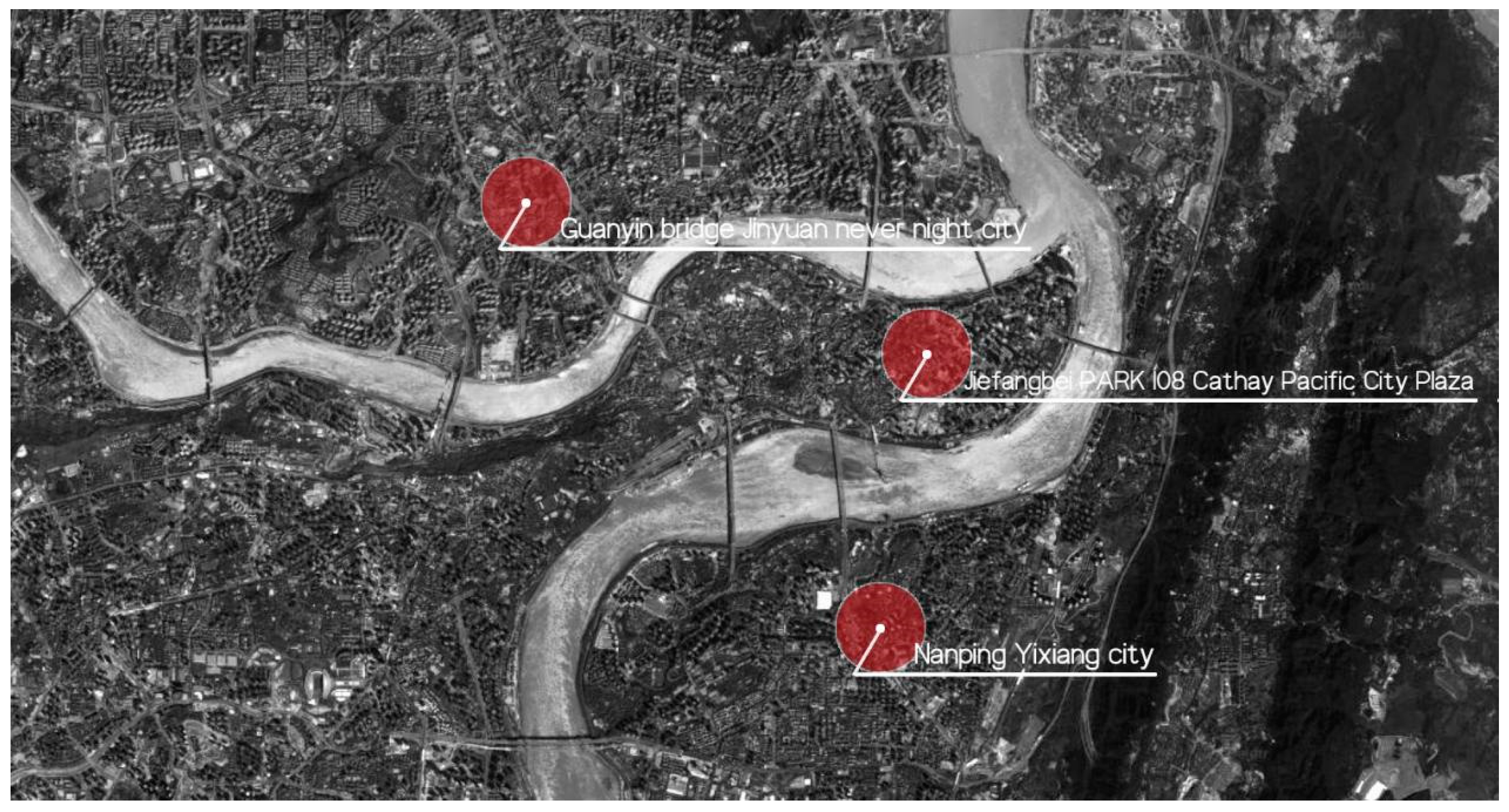
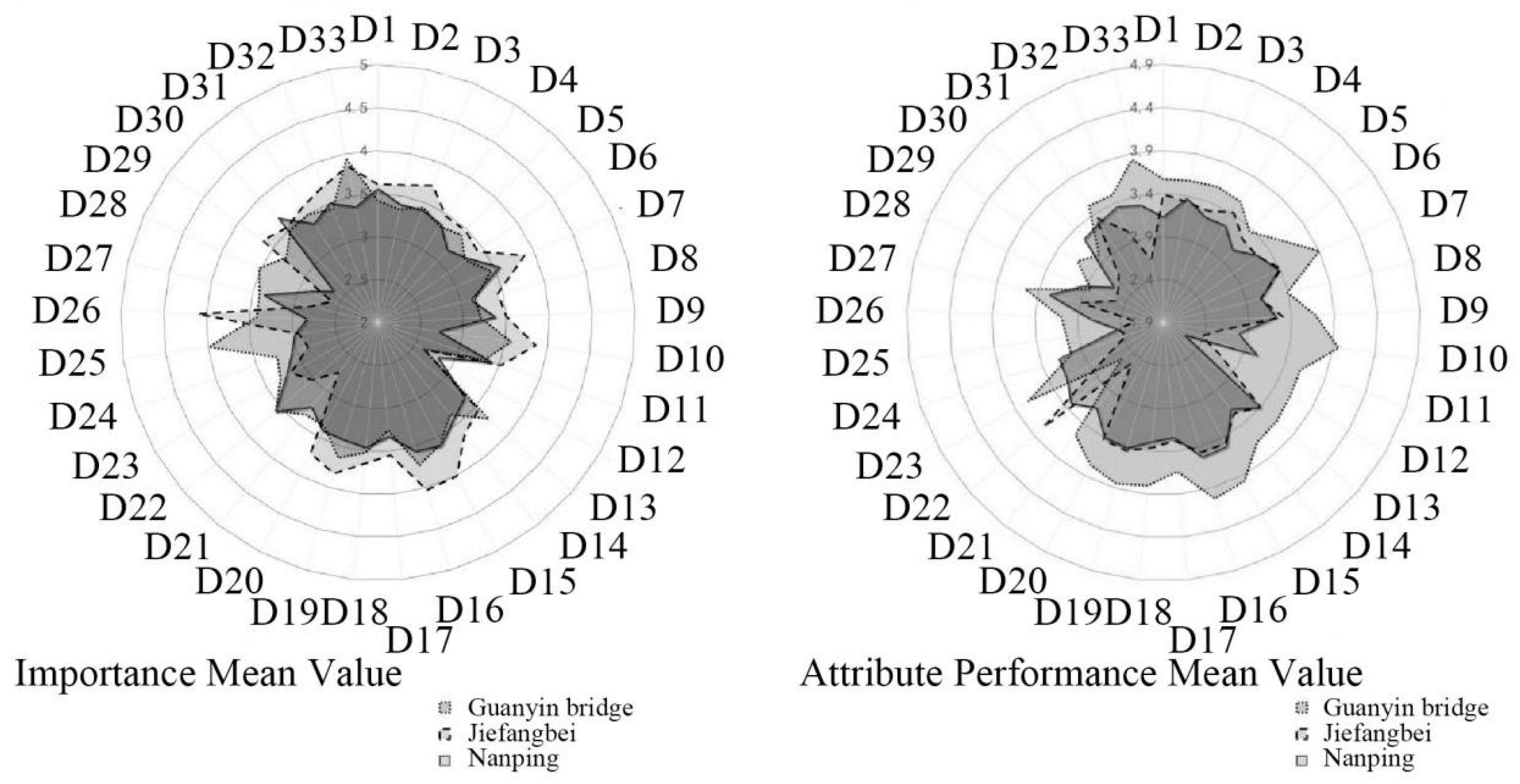
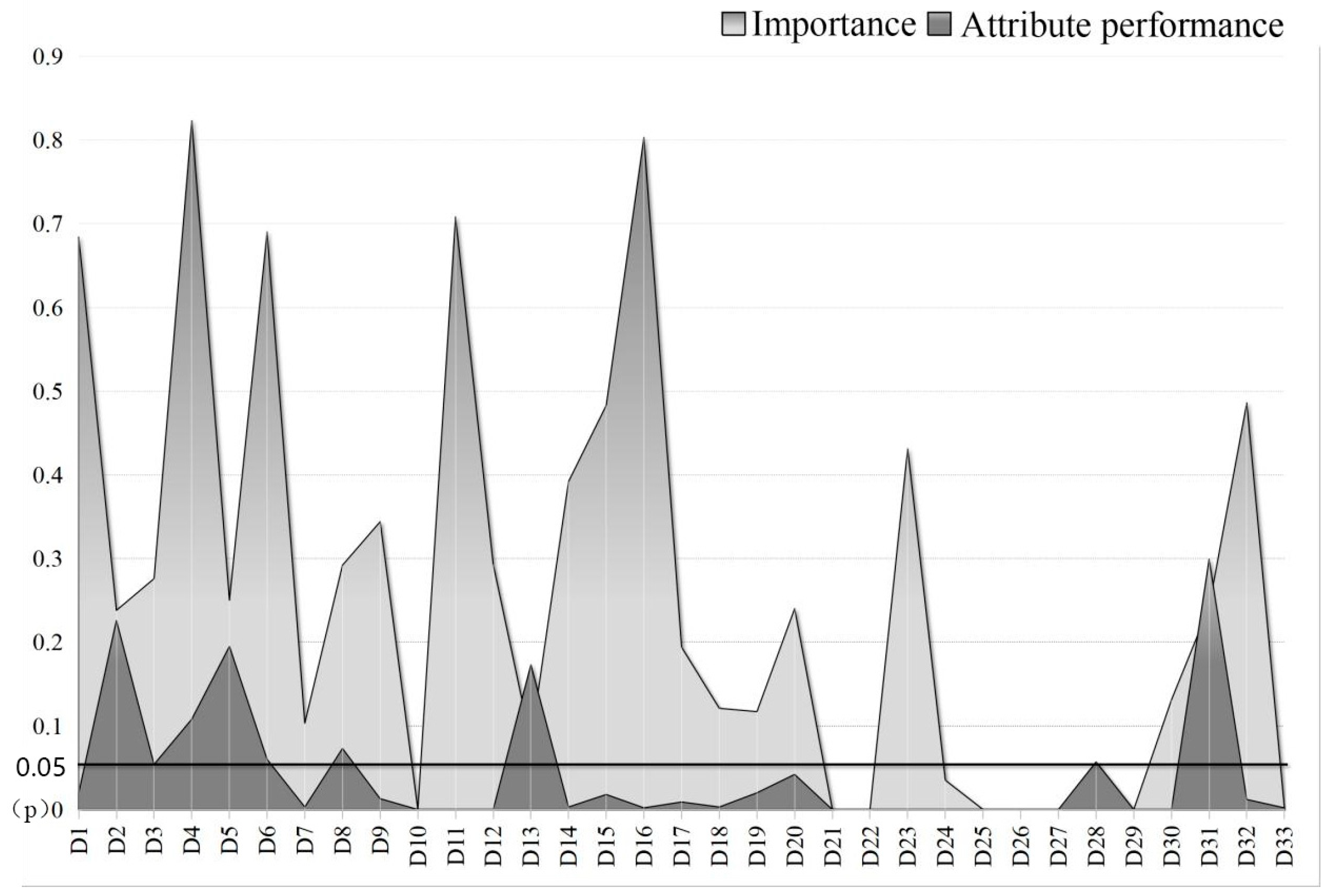

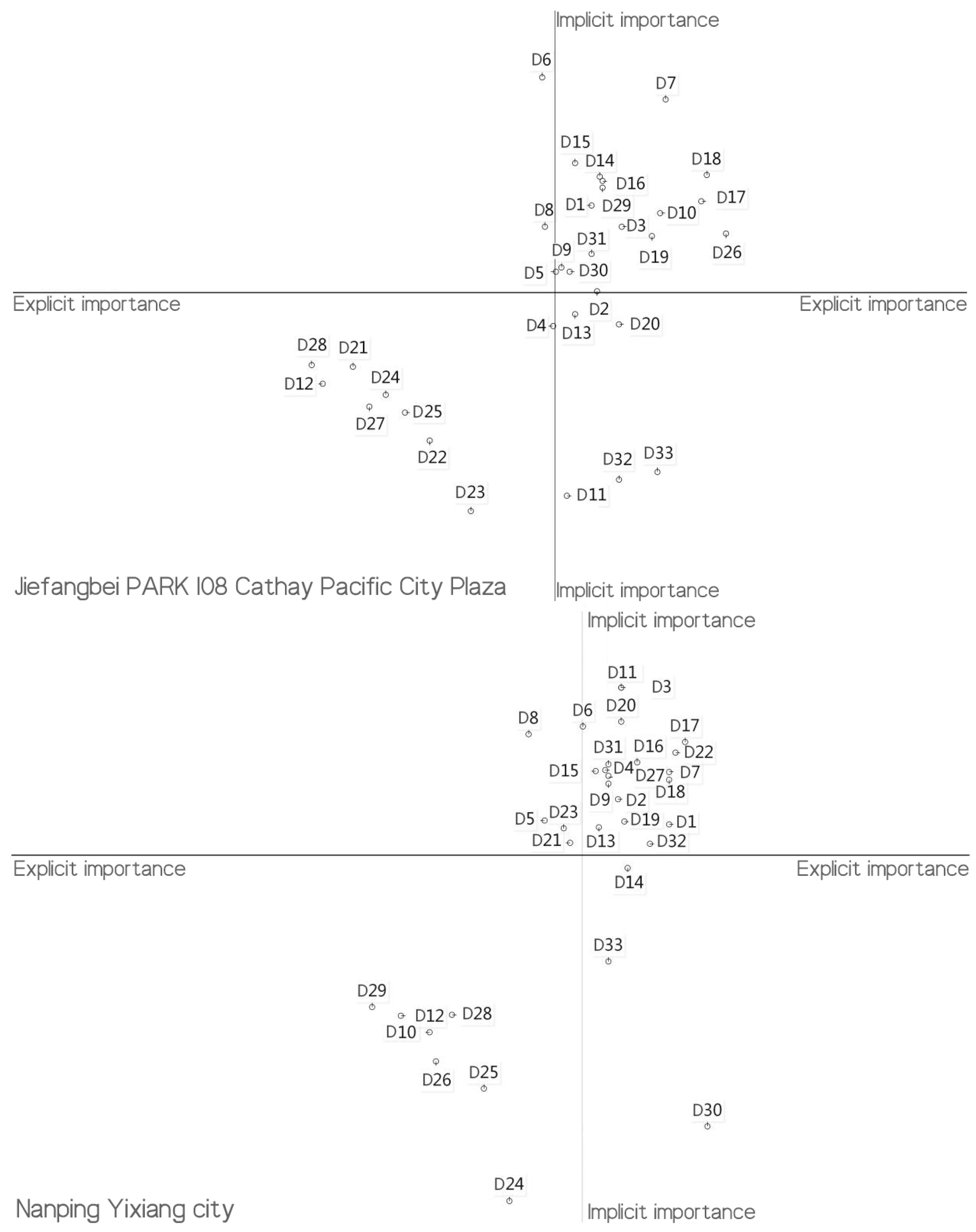
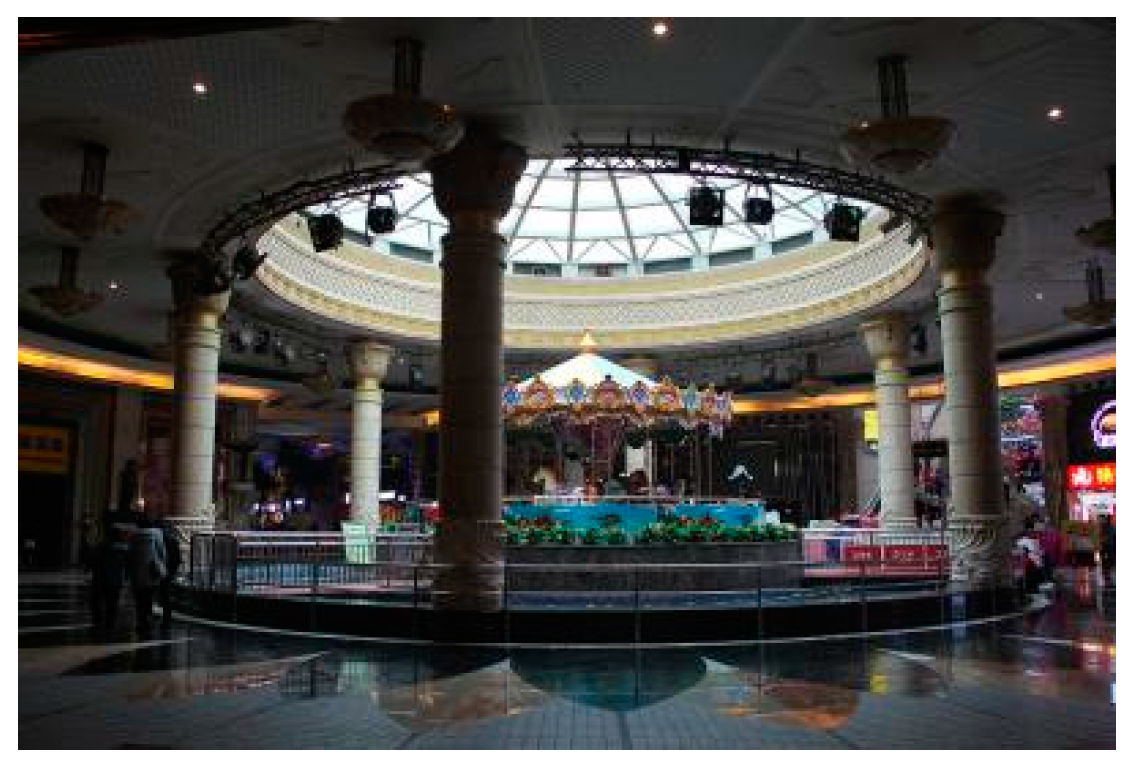
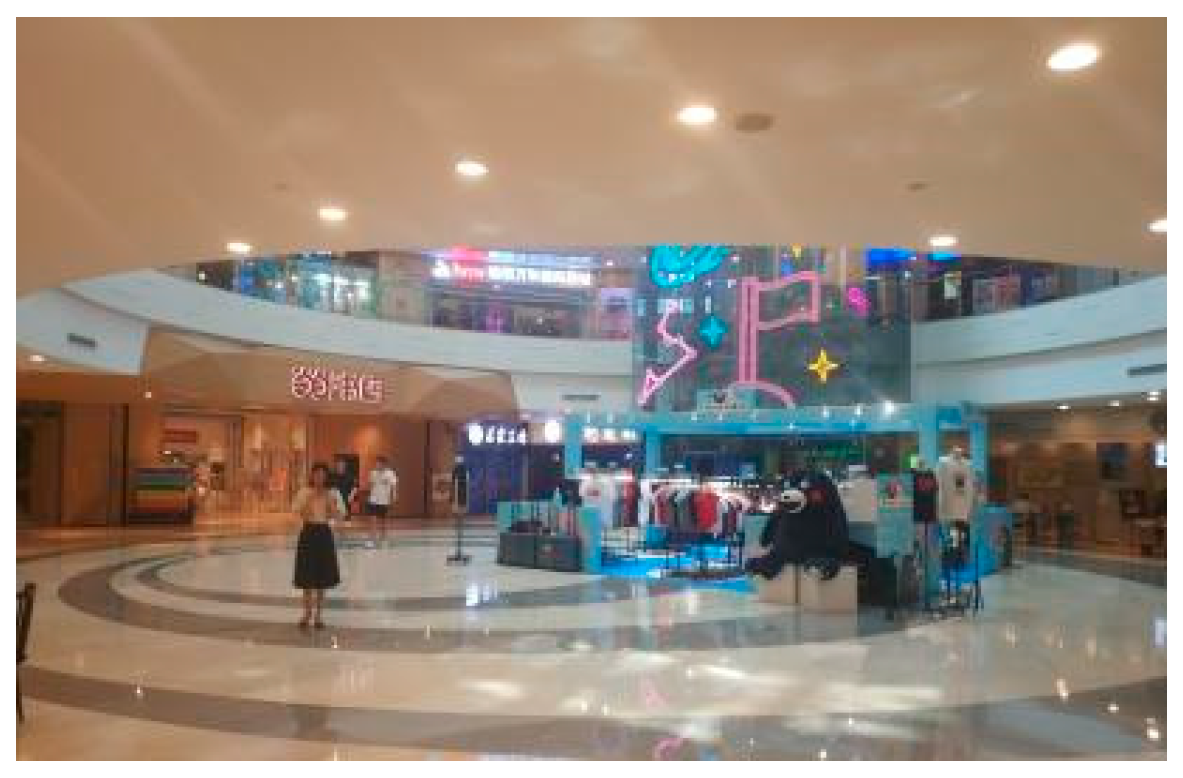
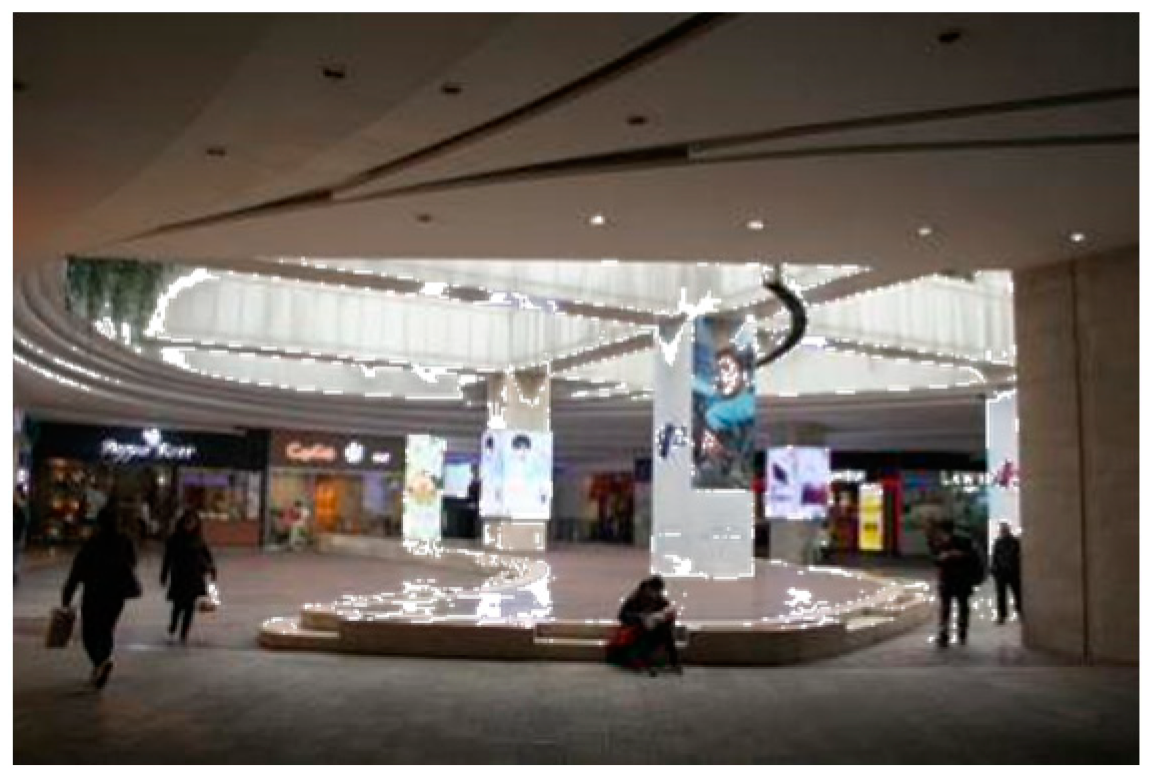
| Improvement Priority | Quadrant | Attribute Performance Ranking |
|---|---|---|
| 1 | Basic Element | 22–33 |
| 2 | Important element | 22–33 |
| 3 | Attractive element | 22–33 |
| 4 | Basic Element | 11–22 |
| 5 | Important element | 11–22 |
| 6 | Attractive element | 11–22 |
| B1 Spatial scale and form elements | C1 Spatial scale | D1 Plane ratio |
| D2 Section ratio | ||
| C2 Spatial form | D3 Plane layout | |
| D4 Atrium Sectional Form | ||
| B2 Spatial limit elements | C3 Top interface | D5 Roof opening diameter |
| D6 Roof shape | ||
| D7 Roof transparency | ||
| C4 Vertical interface | D8 Wall form change | |
| D9 Ratio of door and window openings | ||
| D10 Fence and railing form | ||
| C5 Bottom interface | D11 Degree of ground undulation | |
| D12 Balcony form | ||
| B3 Spatial physical environment elements | C6 Light environment | D13 Artificial lighting |
| D14 Natural lighting | ||
| C7 Sound environment | D15 Sound comfort | |
| D16 Sound preference | ||
| C8 Ventilation | D17 Ventilation | |
| C9 Thermal environment | D18 Temperature and humidity | |
| B4 Space facility elements | C10 Landscape facility | D19 Wall material and color |
| D20 Floor pavement pattern | ||
| D21 Plane greening | ||
| D22 Vertical greening | ||
| D23 Landscape furniture | ||
| D24 Water feature | ||
| C11Transportation facility | D25 Escalator setup | |
| D26 Elevator setup | ||
| D27 Stair Step Dimensions | ||
| D28 Ramp shape and width | ||
| D29 Winding corridor, verandah form | ||
| C12 Guide facility | D30 Map marking | |
| D31 Underground traffic sign | ||
| C13 Rest facility | D32 Form of rest seat | |
| D33 Number of rest seat |
| Age | Gender | ||||
|---|---|---|---|---|---|
| 18–25 | 26–35 | 36–45 | Over 46 | Male | Female |
| 25% | 25% | 25% | 25% | 42% | 58% |
| Questionnaire | Name | Nanping | Jiefangbei | Guanyin Bridge |
|---|---|---|---|---|
| Attribute Performance | Cronbach Alpha value | 0.925 | 0.94 | 0.94 |
| Number | 33 | 33 | 33 | |
| Importance | Cronbach Alpha value | 0.963 | 0.878 | 0.884 |
| Item number | 33 | 33 | 33 | |
| Attribute Performance | Kaiser-Meyer-Olkin | 0.882 | 0.901 | 0.898 |
| Bartlett Sphere Test | 0 | 0 | 0 | |
| Importance | Kaiser-Meyer-Olkin | 0.925 | 0.754 | 0.825 |
| Bartlett Sphere Test | 0 | 0 | 0 |
| Guanyin Bridge | Jiefangbei | Nanping | ||||
|---|---|---|---|---|---|---|
| Score | Rank | Score | Rank | Score | Rank | |
| D1 Plane ratio | 0.688 | 2 | 0.567 | 9 | 0.580 | 19 |
| D2 Profile ratio | 0.594 | 8 | 0.466 | 19 | 0.606 | 16 |
| D3 Plane layout | 0.517 | 14 | 0.542 | 11 | 0.721 | 1 |
| D4 Atrium Sectional Form | 0.661 | 4 | 0.425 | 22 | 0.636 | 10 |
| D5 Roof opening diameter | 0.601 | 7 | 0.489 | 17 | 0.584 | 17 |
| D6 Roof shape | 0.683 | 3 | 0.718 | 1 | 0.681 | 4 |
| D7 Roof transparency | 0.628 | 5 | 0.692 | 2 | 0.634 | 12 |
| D8 Wall form change | 0.612 | 6 | 0.542 | 12 | 0.673 | 5 |
| D9 Ratio of door and window openings | 0.521 | 13 | 0.494 | 16 | 0.622 | 15 |
| D10 Fence, railing form | 0.532 | 12 | 0.558 | 10 | 0.383 | 28 |
| D11Degree of ground undulation | 0.561 | 10 | 0.225 | 32 | 0.721 | 2 |
| D12 Balcony form | 0.358 | 28 | 0.357 | 25 | 0.366 | 29 |
| D13 Artificial lighting | 0.492 | 20 | 0.439 | 20 | 0.577 | 20 |
| D14 Natural lighting | 0.517 | 15 | 0.601 | 5 | 0.535 | 24 |
| D15 Sound comfort | 0.696 | 1 | 0.617 | 3 | 0.635 | 11 |
| D16 Sound preference | 0.515 | 16 | 0.596 | 6 | 0.644 | 8 |
| D17 Ventilation | 0.513 | 17 | 0.572 | 8 | 0.665 | 6 |
| D18 Temperature and humidity | 0.541 | 11 | 0.603 | 4 | 0.626 | 14 |
| D19 Wall material and color | 0.593 | 8 | 0.531 | 14 | 0.583 | 18 |
| D20 Floor Pavement Pattern | 0.469 | 22 | 0.427 | 21 | 0.686 | 3 |
| D21 Plane greening | 0.486 | 21 | 0.377 | 24 | 0.561 | 22 |
| D22 Vertical greening | 0.199 | 32 | 0.290 | 29 | 0.654 | 7 |
| D23 Landscape furniture | 0.467 | 23 | 0.207 | 33 | 0.576 | 21 |
| D24 Water feature | 0.374 | 26 | 0.344 | 26 | 0.192 | 33 |
| D25 Escalator setup | 0.398 | 25 | 0.323 | 28 | 0.308 | 31 |
| D26 Elevator setup | 0.341 | 30 | 0.534 | 13 | 0.336 | 30 |
| D27 Stair Step Dimensions | 0.513 | 18 | 0.330 | 27 | 0.630 | 13 |
| D28 Ramp shape and width | 0.258 | 31 | 0.379 | 23 | 0.384 | 27 |
| D29 Winding corridor, verandah form | 0.347 | 29 | 0.588 | 7 | 0.392 | 26 |
| D30 Map Marking | 0.452 | 24 | 0.489 | 18 | 0.269 | 32 |
| D31 Underground traffic sign | 0.508 | 19 | 0.510 | 15 | 0.642 | 9 |
| D32 Form of rest seat | 0.361 | 27 | 0.244 | 31 | 0.560 | 23 |
| D33 Number of rest seat | 0.194 | 33 | 0.253 | 30 | 0.439 | 25 |
| Attribution of Elements | Guanyin Bridge | Jiefangbei | Nanping |
|---|---|---|---|
| Basic element | D30 Map Marking | D33 Number of rest seat | D30 Map Marking |
| D33 Number of rest seat | D11Degree of ground undulation | D14 Natural lighting | |
| D25 Escalator setup | D13 Artificial lighting | D31 Underground traffic sign | |
| D28 Ramp shape and width | D20 Floor Pavement Pattern | ||
| D22 Vertical greening | D32 Form of rest seat | ||
| Important element | D3 Plane layout | D3 Plane layout | D3 Plane layout |
| D7 Roof transparency | D7 Roof transparency | D7 Roof transparency | |
| D16 Sound preference | D16 Sound preference | D16 Sound preference | |
| D17 Ventilation | D17 Ventilation | D17 Ventilation | |
| D18 Temperature and humidity | D18 Temperature and humidity | D18 Temperature and humidity | |
| D19 Wall material and color | D19 Wall material and color | D19 Wall material and color | |
| D31 Underground traffic sign | D31 Underground traffic sign | D31 Underground traffic sign | |
| D10 Fence, railing form | D1 Plane ratio | D1 Plane ratio | |
| D13 Artificial lighting | D2 Section ratio | D2 Section ratio | |
| D15 Sound comfort | D15 Sound comfort | ||
| D9 Ratio of door and window openings | D9 Ratio of door and window openings | ||
| D10 Fence, railing form | D13 Artificial lighting | ||
| D5 Roof opening diameter | D4 Atrium Sectional Form | ||
| D14 Natural lighting | D6 Roof shape | ||
| D26 Elevator setup | D11 Degree of ground undulation | ||
| D29 Winding corridor, verandah form | D22 Vertical greening | ||
| D30 Map Marking | D20 Floor Pavement Pattern | ||
| D27 Stair Step Dimensions | |||
| D32 Form of rest seat | |||
| D33 Number of rest seat | |||
| Unimportant element | D12 Balcony form | D12 Balcony form | D12 Balcony form |
| D24 Water feature | D24 Water feature | D24 Water feature | |
| D21 Plane greening | D21 Plane greening | D25 Escalator setup | |
| D23 Landscape furniture | D23 Landscape furniture | D26 Elevator setup | |
| D26 Elevator setup | D25 Escalator setup | D29 Winding corridor, verandah form | |
| D29 Winding corridor, verandah form | D4 Atrium Sectional Form | D10 Fence, railing form | |
| D20 Floor Pavement Pattern | D22 Vertical greening | D28 Ramp shape and width | |
| D32 Form of rest seat | D27 Stair Step Dimensions | ||
| D28 Ramp shape and width | |||
| Attractive element | D8 Wall form change | D8 Wall form change | D8 Wall form change |
| D6 Roof shape | D6 Roof shape | D5 Roof opening diameter | |
| D1 Plane ratio | D23 Landscape furniture | ||
| D2 Section ratio | D21 Plane greening | ||
| D5 Roof opening diameter | |||
| D4 Atrium Sectional Form | |||
| D11 Degree of ground undulation | |||
| D9 Ratio of door and window openings | |||
| D14 Natural lighting | |||
| D15 Sound comfort | |||
| D27 Stair Step Dimensions |
| Guanyin Bridge | Jiefangbei | Nanping | |
|---|---|---|---|
| Priority 1 | D33 Number of rest seat | D11Degree of ground undulation | |
| D25 Escalator setup | D33 Number of rest seat | ||
| D28 Ramp shape and width | |||
| D22 Vertical greening | |||
| Priority 2 | D31 Underground traffic sign | D30 Map Marking | D11 Degree of ground undulation |
| D10 Fence, railing form | |||
| D26 Elevator setup | |||
| D29 Winding corridor, verandah form | |||
| Priority 3 | D8 Wall form change | D8 Wall form change | |
| D5 Roof opening diameter | D21 Plane greening | ||
| Priority 4 | D30 Map Marking | D32 Form of rest seat | D30 Map Marking |
| D14 Natural lighting | |||
| D31 Underground traffic sign | |||
| Priority 5 | D3 Plane layout | D3 Plane layout | D3 Plane layout |
| D13 Artificial lighting | D14 Natural lighting | D15 Sound comfort | |
| D15 Sound comfort | D31 Underground traffic sign | ||
| D31 Underground traffic sign | D33 Number of rest seat | ||
| D2 Section ratio | D6 Roof shape | ||
| D5 Roof opening diameter | D1 Plane ratio | ||
| D9 Ratio of door and window openings | D4 Atrium Sectional Form | ||
| D27 Stair Step Dimensions | |||
| D9 Ratio of door and window openings | |||
| Priority 6 | D11 Degree of ground undulation | D8 Wall form change | D31 Underground traffic sign |
| D14 Natural lighting | D6 Roof shape | ||
| D15 Sound comfort | |||
| D6 Roof shape | |||
| D1 Plane ratio | |||
| D2 Section ratio | |||
| D4 Atrium Sectional Form | |||
| D27 Stair Step Dimensions |
Disclaimer/Publisher’s Note: The statements, opinions and data contained in all publications are solely those of the individual author(s) and contributor(s) and not of MDPI and/or the editor(s). MDPI and/or the editor(s) disclaim responsibility for any injury to people or property resulting from any ideas, methods, instructions or products referred to in the content. |
© 2023 by the authors. Licensee MDPI, Basel, Switzerland. This article is an open access article distributed under the terms and conditions of the Creative Commons Attribution (CC BY) license (https://creativecommons.org/licenses/by/4.0/).
Share and Cite
Jia, X.; Yan, B.; Wang, J.; Fang, L. Evaluation and Optimization Paths of Design Elements of Underground Building Atria Based on IPA–Kano Model. Buildings 2023, 13, 789. https://doi.org/10.3390/buildings13030789
Jia X, Yan B, Wang J, Fang L. Evaluation and Optimization Paths of Design Elements of Underground Building Atria Based on IPA–Kano Model. Buildings. 2023; 13(3):789. https://doi.org/10.3390/buildings13030789
Chicago/Turabian StyleJia, Xinming, Bo Yan, Jinyao Wang, and Ling Fang. 2023. "Evaluation and Optimization Paths of Design Elements of Underground Building Atria Based on IPA–Kano Model" Buildings 13, no. 3: 789. https://doi.org/10.3390/buildings13030789
APA StyleJia, X., Yan, B., Wang, J., & Fang, L. (2023). Evaluation and Optimization Paths of Design Elements of Underground Building Atria Based on IPA–Kano Model. Buildings, 13(3), 789. https://doi.org/10.3390/buildings13030789







